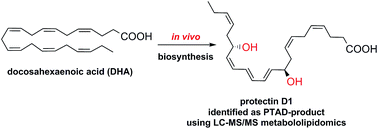Selective identification of specialized pro-resolving lipid mediators from their biosynthetic double di-oxygenation isomers
Abstract
The n-3 polyunsaturated fatty acids are substrates for lipoxygenases and cyclooxygenases. During inflammatory processes, these enzymes form several distinct families of oxygenated polyunsaturated fatty acids coined specialized pro-resolving lipid mediators. Structural elucidation of these natural products using LC-MS/MS based metabololipidomics with the pico- to nanogram amounts of biosynthetic material available have been performed. The specialized pro-resolving lipid mediators display stereospecific and potent anti-inflammatory and pro-resolving actions. Most often the different families among these mediators are chemically characterized by two or three chiral, secondary alcohols, separated by either an E,E,Z-triene or an E,Z,E,E-tetraene moiety. The lipoxygenases also form other oxygenated polyunsaturated natural products, coined double di-oxygenation products, that are constitutional isomers of the protectin and maresin families of specialized pro-resolving lipid mediators. Very often these products exhibit similar chromatographic properties and mass spectrometrical fragment ions as the pro-resolving mediators. In addition, the double di-oxygenation products are sometimes formed in larger amounts than the specialized pro-resolving lipid mediators. Thus, it is not always possible to distinguish between the specialized pro-resolving mediators and their double di-oxygenation isomers in biological systems, using LC/MS-based techniques. Herein, a convenient and easy-to-use protocol to meet this challenge is presented.


 Please wait while we load your content...
Please wait while we load your content...